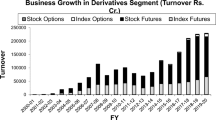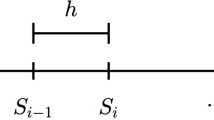Abstract
This paper aims to unify exotic option closed formulas by generalizing a large class of existing formulas and by setting a framework that allows for further generalizations. The formula presented covers options from the plain vanilla to most, if not all, mountain range exotic options and is developed in a multi-asset, multi-currency Black–Scholes model with time dependent parameters. It particular, it focuses on payoffs that depend on the distributions of the underlyings prices at multiple but set time horizons. The general formula not only covers existing cases but also enables the combination of diverse features from different types of exotic options. It also creates implicitly a language to describe payoffs that can be used in industrial applications to decouple the functions of payoff definition from pricing functions. Examples of several exotic options are presented, benchmarking the closed formulas’ performance against Monte Carlo simulations. Results show a consistent over performance of the closed formula reducing calculation time by double digit factors.
Similar content being viewed by others
References
Björk T. (1998) Arbitrage theory in continuous time. Oxford University Press, New York
Björk, T., & Landén, C. (2002). On the term structure of futures and forward prices. In Mathematical Finance Bachelier Congress 2000, pp. 111–150.
Carr P. (1995) Two extensions to barrier options valuation. Applied Mathematical Finance 2(3): 173–209
Carr P. (2001) Deriving derivatives of derivative securities.. Journal of Computational Finance, 4(2): 5–29
Conze A., Conze A. (1991) Path dependent options: The case of lookback options. Journal of Finance, 46(5): 1893–1907
Dudley R. (2002) Real analysis and probability. Cambridge University Press, UK
Geman H., El Karoui N., Rochet J. C. (1995) Changes of Numéraire, changes of probability measure and option pricing. Journal of Applied Probability 32: 443–458
Genz A. (1992) Numerical computation of multivariate normal probabilities. Journal of Computational and Graphical Statistics 1(2): 141–149
Goldman M., Soson H., Gatto M. (1979) Path dependent options: Buy at the low, sell at the high. Journal of Finance 34(5): 1111–1127
Harrison J., Kreps D. (1979) Martingales and arbitrage in multiperiod securities markets. Journal of Economic Theory 20: 381–408
Harrison J., Pliska S. (1981) Martingales and stochastic integrals in the theory of continuous trading. Stochastic Processes and their Applications 11: 215–260
Hakala J., Wystup U. (2002) Foreign exchange risk. Risk Books, London
Haug E. (1998) The complete guide to option pricing formulas. McGraw-Hill Professional, New York
Heynen R., Kat H. (1994) Partial barrier options. Journal of Financial Engineering 3(3): 253–274
Hunt, P., & Kennedy, J. (2004). Financial derivatives in theory and practice (revised ed.). England: Wiley
Johnson H. (1987) Options on the minimum and maximum of several assets. Journal of Financial and Quantitative Analysis 22: 277–283
Margrabe W. (1978) The value of an option to exchange one asset for another. Journal of Finance 33: 177–186
Nelken I. (1995) The handbook of exotic options: Instruments, analysis, and applications. McGraw-Hill Professional, New York
Reiß O., Wystup U.(2001). Efficient computation of option price sensitivities using homogeneity and other tricks. The Journal of Derivatives, 9(2), 41–53 (Winter).
Rubinstein M., Reiner E. (1991) Breaking down barriers. Risk Magazine 4(9): 28–35
Shreve S. (2004) Stochastic calculus for finance II, continuous–Time models. Springer, New York
Stulz R. (1982) Options on the minimum and maximum of two risky assets. Journal of Financial Economics 10: 161–185
Večeř J. (2001) A new PDE approach for pricing arithmetic average Asian options. Journal of Computational Finance 4(4): 105–113
Veiga, C. (2004). Expanding further the universe of exotic options closed pricing formulas. Proceedings of the 2004 international conference on stochastic finance.
Veiga C., Wystup U. (2009) Closed formula for options with discrete dividends and its derivatives. Applied Mathematical Finance 16(6): 517–531
Vorst T. (1992) Prices and hedge ratios of average exchange rate options. International Review of Financial Analysis 1: 179–193
Wystup U. (2003) The market price of one-touch options in foreign exchange markets. Derivatives Week 12(13): 8–9
Zhang P. (1997) Exotic options. World Scientific, Singapore
Author information
Authors and Affiliations
Corresponding author
Rights and permissions
About this article
Cite this article
Veiga, C., Wystup, U. & Esquível, M.L. Unifying exotic option closed formulas. Rev Deriv Res 15, 99–128 (2012). https://doi.org/10.1007/s11147-011-9071-8
Published:
Issue Date:
DOI: https://doi.org/10.1007/s11147-011-9071-8
Keywords
- Exotic options
- Mountain range
- Discrete lookback
- Closedformula
- Payoff language
- Multi-asset multi-currency model




